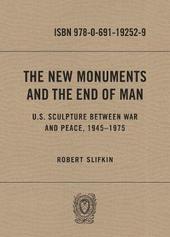
|
The New Monuments and the End of Man: U.S. Sculpture between War and Peace, 1945-1975
Hardback
Main Details
| Title |
The New Monuments and the End of Man: U.S. Sculpture between War and Peace, 1945-1975
|
| Authors and Contributors |
By (author) Robert Slifkin
|
| Physical Properties |
| Format:Hardback | | Pages:248 | | Dimensions(mm): Height 248,Width 178 |
|
| Category/Genre | Art and design styles - from c 1900 to now
Sculpture |
|---|
| ISBN/Barcode |
9780691192529
|
| Classifications | Dewey:731.760973 |
|---|
| Audience | |
|---|
| Illustrations |
103 b/w illus.
|
|
Publishing Details |
| Publisher |
Princeton University Press
|
| Imprint |
Princeton University Press
|
| Publication Date |
5 November 2019 |
| Publication Country |
United States
|
Description
How leading American artists reflected on the fate of humanity in the nuclear era through monumental sculpture In the wake of the atomic bombings of Japan in 1945, artists in the United States began to question what it meant to create a work of art in a world where humanity could be rendered extinct by its own hand. The New Monuments and the End
Author Biography
Robert Slifkin is associate professor of fine arts at New York University's Institute of Fine Arts. He is the author of Out of Time: Philip Guston and the Refiguration of Postwar American Art. He lives in New York City.
Reviews"In an ambitious and compelling interpretation of sculpture between the end of WW II and the end of the Vietnam War, Slifkin (Institute of Fine Arts, NYU) examines the expansion of sculptural aesthetic properties, giving renewed attention to the property of monumentalism. Illuminating work ranging from abstract expressionism to land art, the author looks at this work as sharing a sculptural material presence that acknowledged the 'contemporary space and time of the viewer,' and in so doing offered images of a future Utopian or catastrophic in tone." * Choice * "A tour de force of social art history, following American sculpture's mediation of Cold War anxieties until the end of the Nixon era."---David W. Norman, Art History
|